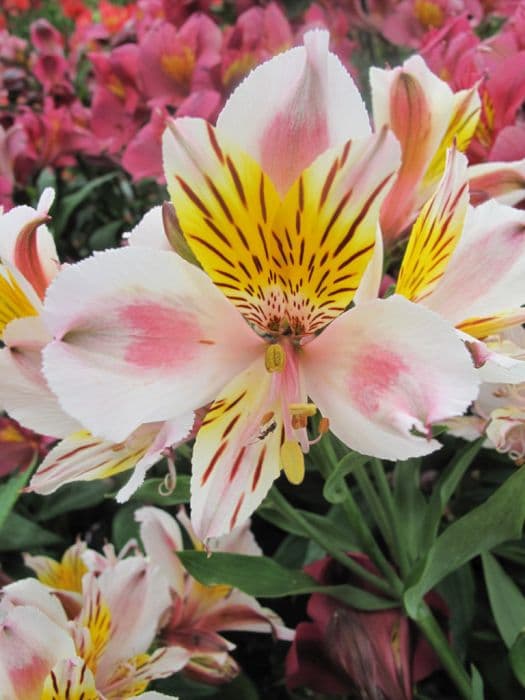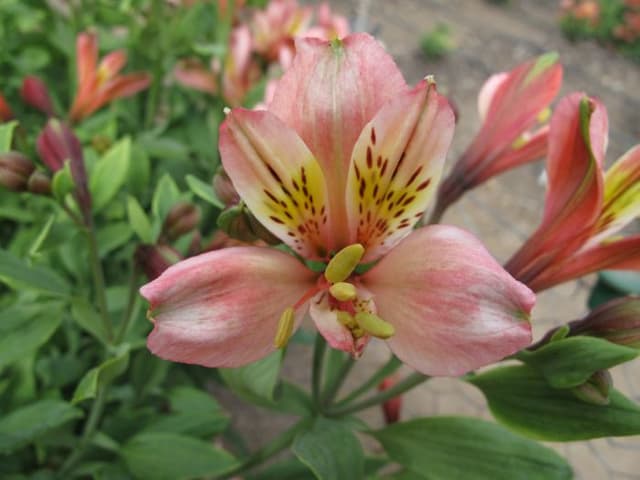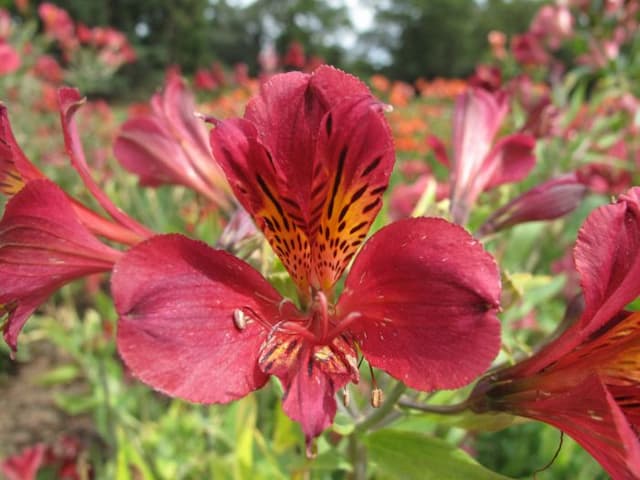Peruvian Lily Alstroemeria 'Sonata'

ABOUT
The Alstroemeria 'Sonata', commonly known as the Peruvian Lily or Lily of the Incas, is a vibrant and showy flowering plant. The blossoms exhibit a palette of hues, commonly featuring shades of pink, red, orange, purple, white or yellow. Each flower is marked by distinctive streaks or spots, adding to its exotic look. The petals portray a symmetrical shape that subtly curves outward and contribute to the plant's overall elegant and luscious appearance. The leaves of the Alstroemeria 'Sonata' grow in an alternating pattern and are typically lance-shaped, presenting an attractive green backdrop that complements the vivid colors of the flowers. Stems appear sturdy and upright, supporting clusters of blooms that give the plant a lush, full look. The overall form of the Alstroemeria 'Sonata' is well-branched, which contributes to its bushy and abundant aesthetic. It's the plant's resilience and the long-lasting nature of its blooms that make it a popular choice for both gardeners and florists. The Peruvian Lily's flowers are not only a feast for the eyes in gardens but are also cherished as cut flowers for their enduring beauty in bouquets and floral arrangements. The Peruvian Lily personifies a blend of elegance, hardiness, and vivid coloration that enlivens any space it occupies.
About this plant
 Names
NamesFamily
Alstroemeriaceae
Synonyms
Peruvian Lily, Lily of the Incas, Parrot Lily
Common names
Alstroemeria 'Sonata'.
 Toxicity
ToxicityTo humans
Peruvian Lily is generally considered non-toxic to humans. However, it's crucial to remember that sensitive individuals may still experience mild irritation or an allergic reaction when handling the plant or ingesting any part of it, which may manifest as gastrointestinal discomfort, skin irritation, or other allergic symptoms.
To pets
Peruvian Lily can be irritating to pets if ingested, particularly cats and dogs. Symptoms of poisoning can include vomiting, diarrhea, and drooling. In most cases, the plant causes mild to moderate gastrointestinal upset, but the consequences are not usually severe. If you suspect your pet has ingested Peruvian Lily, it is important to monitor them closely and consult a veterinarian if symptoms persist.
 Characteristics
CharacteristicsLife cycle
Perennials
Foliage type
Deciduous
Color of leaves
Green
Flower color
Mixed
Height
1-2 feet (30-60 cm)
Spread
1-2 feet (30-60 cm)
Plant type
Bulb
Hardiness zones
7
Native area
South America
Benefits
 General Benefits
General Benefits- Long-lasting blooms: Alstroemeria 'Sonata' is known for its long flowering period, which can add consistent color to a garden or home for an extended time.
- Attracts pollinators: The vibrant flowers can attract bees, butterflies, and hummingbirds, promoting biodiversity in the garden.
- Excellent cut flowers: The cut stems of Alstroemeria 'Sonata' are durable and can last up to two weeks in a vase, making them ideal for floral arrangements.
- Versatile planting options: This plant can be used in borders, containers, or as a massed bedding plant, providing flexibility in garden design.
- Drought tolerance: Once established, Alstroemeria 'Sonata' has a level of drought tolerance, making it a good choice for water-wise gardens.
- Vibrant color palette: The plant produces a variety of colors, which can help to create a visually appealing garden space.
- Low maintenance: Alstroemeria 'Sonata' requires minimal upkeep, making it suitable for gardeners of all skill levels.
- Cold hardy: It is relatively cold hardy, which allows it to be grown in a variety of climates and extends its growing season in cooler regions.
- Rapid growth: The plant can grow and establish itself quickly, providing fast results for landscaping projects.
 Medical Properties
Medical PropertiesThis plant is not used for medical purposes.
 Air-purifying Qualities
Air-purifying QualitiesThis plant is not specifically known for air purifying qualities.
 Other Uses
Other Uses- Alstroemeria 'Sonata', commonly known as Peruvian Lily, can be used in crafting natural dyes for fabrics, yielding colors that vary depending on the mordant used.
- The sturdy stems of Peruvian Lilies make them suitable for creating lightweight garden supports for other more delicate plants in the garden.
- When dried, the seed pods of Peruvian Lily can be used in decorative arrangements, adding texture and interest to the composition.
- The petals of the Peruvian Lily can be used in the art of pressed flower crafts, such as bookmarks and greeting cards, for their vivid colors and durability.
- Dried Peruvian Lily petals can be incorporated into homemade potpourri mixes, contributing a soft, floral fragrance when combined with essential oils.
- The Peruvian Lily's vibrant flowers can serve as natural confetti for celebrations, providing an eco-friendly alternative to synthetic materials.
- Peruvian Lily plants, being resilient, can be used for educational purposes, teaching children or gardening beginners about plant care and propagation.
- In culinary practices, though not commonly known as an edible flower, the petals of certain varieties of Peruvian Lily may be used as a colorful garnish for salads, provided they are pesticide-free.
- Photographers may utilize the striking blooms of Peruvian Lilies as props or background subjects in close-up and macro photography to capture the intricacies of plant structures.
- Peruvian Lily, with its diverse range of colors, can be used in color therapy practices, where colors are utilized to adjust body vibrations to frequencies that result in health and harmony.
Interesting Facts
 Feng Shui
Feng ShuiThe Peruvian Lily is not used in Feng Shui practice.
 Zodiac Sign Compitability
Zodiac Sign CompitabilityThe Peruvian Lily is not used in astrology practice.
 Plant Symbolism
Plant Symbolism- Friendship: Alstroemeria, commonly known as Peruvian Lily, often represents strong bonds of friendship due to its many clusters of blooms, symbolizing the many facets of a friendship.
- Devotion: The Peruvian Lily is a symbol of the dedication and commitment in a relationship, making it a popular choice for delivery to partners and loved ones.
- Wealth and Prosperity: With their vibrant colors and lush appearance, these blooms are commonly interpreted as symbols of wealth and abundance.
- Achievement: Seen as a flower of aspiration and striving, the Peruvian Lily can represent the pursuit of dreams and the celebration of achievements.
- Longevity: The hardiness and longevity of the flower make it a symbol of endurance and ongoing life, sending a wish for a long and healthy existence.
 Water
WaterThe Peruvian Lily should be watered regularly to keep the soil moist but not soggy. Typically, this would mean watering about once a week, but this frequency may need to be increased during hot, dry periods or if the plant is in a container. Provide roughly one to two gallons of water each time, ensuring even distribution throughout the soil. During the winter months, reduce the amount of water to correspond with the plant's reduced growth and evaporation rates.
 Light
LightPeruvian Lilies thrive in bright, indirect light. The ideal location would be in a spot that receives morning sunlight and partial shade in the afternoon to prevent the foliage from scorching. However, they can also adapt to full sun conditions provided they are not exposed to the harshest midday sun, especially in hotter climates.
 Temperature
TemperatureThe Peruvian Lily prefers a temperature range between 65 to 75 degrees Fahrenheit for optimal growth. They can survive minimum temperatures down to around 50 degrees Fahrenheit, but frost and temperatures below freezing can damage the plant. In summer, high temperatures above 90 degrees Fahrenheit may also stress the plant, so some shade can be beneficial during the hottest part of the day.
 Pruning
PruningPrune the Peruvian Lily to encourage bushier growth, remove spent blooms, and maintain a tidy appearance. Deadhead flowers regularly to prolong blooming and cut back foliage in late fall or early winter after the growing season has ended. Pruning can be done every few weeks during the blooming period to remove any dead or yellowing leaves or stems.
 Cleaning
CleaningAs needed
 Soil
SoilThe Peruvian Lily thrives in fertile, well-draining soil with a pH between 6.5 and 7.5. A mix of loam, peat, and coarse sand is ideal for ensuring proper drainage and nutrition. Adding organic matter annually will enrich the soil quality.
 Repotting
RepottingPeruvian Lilies should be repotted every two to three years, or when the clumps become overcrowded. This rejuvenates the plant and promotes more vigorous growth and flowering.
 Humidity & Misting
Humidity & MistingPeruvian Lilies prefer moderate to high humidity levels. The ideal humidity range for best growth is between 40% and 60%.
 Suitable locations
Suitable locationsIndoor
Provide bright light, well-draining soil, and moderate humidity.
Outdoor
Plant in partial shade, fertile soil, and protect from harsh winds.
Hardiness zone
7-10 USDA
 Life cycle
Life cycleThe Peruvian Lily 'Sonata', starts its life cycle as a rhizome, which is planted in fertile, well-drained soil in a site with full sun or partial shade. The plant then grows into a clump of leafy stems, with linear leaves, and enters the vegetative stage where it focuses on accumulating nutrients and energy. As it matures, it develops flower buds in the late spring or early summer, leading to the blooming stage where it showcases its colorful and often speckled trumpet-shaped flowers. After pollination, which can occur through insect activity or self-fertilization, the flowers fade and seed pods may form, representing the reproductive stage. The seeds disperse when the pods dehisce, which can result in the germination of new plants if the conditions are favorable. Throughout the growing season, the Peruvian Lily 'Sonata' may undergo cycles of growth and dormancy, especially in regions with colder winters, during which the above-ground foliage dies back and the plant survives through its underground rhizomes until favorable conditions return.
 Propogation
PropogationPropogation time
Spring to Summer
The most popular way to propagate the Peruvian Lily 'Sonata' is through division, commonly carried out in spring or early summer when the plant's growth is most active. The process involves digging up the entire plant and gently separating the clustered tubers by hand or with a sharp knife. Each section should have at least one growth point, often referred to as an "eye." Once divided, the pieces can be replanted in well-draining soil, about 6 to 8 inches (15 to 20 centimeters) deep, and watered thoroughly. The divisions should be spaced about 12 to 18 inches (30 to 45 centimeters) apart to allow room for growth. This method stimulates quick establishment and will usually result in blooming the following season.



![Peruvian lily [Inca Glow]](/_next/image?url=https%3A%2F%2Fplants-admin.emdemapps.com%2Fimages%2Fplants%2F%2Fimages%2F604b5e99e48d9.png&w=640&q=75)
![Peruvian lily [Inca Smile]](/_next/image?url=https%3A%2F%2Fplants-admin.emdemapps.com%2Fimages%2Fplants%2F%2Fimages%2F604b5cad8fa91.png&w=640&q=75)
![Peruvian lily [Inticancha Passion]](/_next/image?url=https%3A%2F%2Fplants-admin.emdemapps.com%2Fimages%2Fplants%2F%2Fimages%2F604b5f7a78c8d.png&w=640&q=75)


![Peruvian lily [Summer Breeze]](/_next/image?url=https%3A%2F%2Fplants-admin.emdemapps.com%2Fimages%2Fplants%2F%2Fimages%2F604b6401573b7.png&w=640&q=75)
